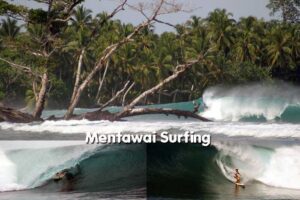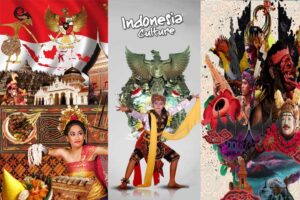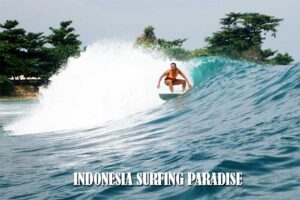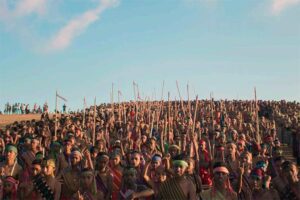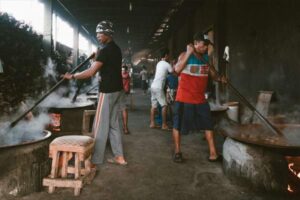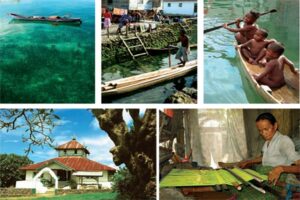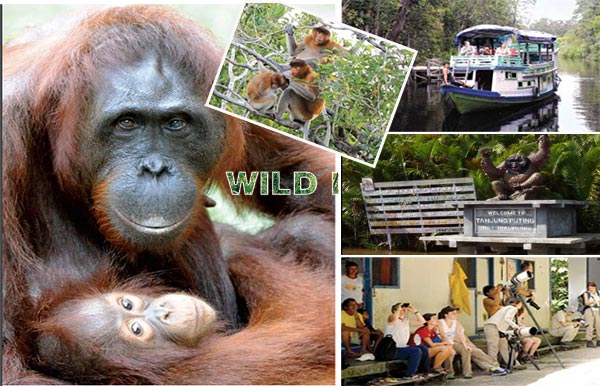
Borneo as one of the wild in Indonesia. Sitting on the upper deck of our river boat (“klotok”) in the Tanjung Puting National Park in the late afternoon, the sights and sounds of approaching dusk in the Borneo jungle are all around us.
Proboscis monkeys sit perched high in the branches before suddenly leaping across large spaces of open air to grasp the next flimsy branch. Swallows and bats swoop along the surface of the river as the golden evening light on the palm trees slowly gives way to darkness and the sounds of the night.
The island of Borneo still conjures up images in one’s imagination as one of the world’s last wild places. The tropical rainforest of Tanjung Puting National Park on the island’s southern coast is home not only to a large concentration of orangutans, but also many wild and exotic animals like the clouded leopard, leopard cat, crocodiles, many types of lizards and snakes, sun bears, birds of prey, water birds and hornbills. Tanjung Puting National Park became a game reserve in 1935 and was upgraded to a National Park in 1982.
Real orangutan sanctuary!
We are on our own private klotok just a few kilometers from Camp Leakey in the middle of the park. Camp Leakey was established in 1971 by Dr Biruté Galdikas. It is home to both wild and rehabilitated orang utans. Camp Leakey is in a remote location and can only be reached by boat. Tanjung Puting, with about a population of about 5,000 orangutans, is renowned as probably the best place in the world to see them in the wild. Here at Camp Leakey, a rehabilitation centre for orangutans rescued from captivity, orangutans are taught the skills of the wild and how to survive in nature. Once the lengthy process is finished they return to the jungle.
The river journey to Camp Leakey begins with a trip by klotok across the Kumai River, past the cargo terminals and oceangoing ships before entering to the smaller Sekonyer River. Approaching Camp Leakey the river water becomes jet black in colour as a result of tannin in the water. Slowly cruising the palm fringed banks of the river is a wonderful way to see families of proboscis monkeys, hornbills, wild orangutan, and sometimes even crocodiles.
After several hours of klotok travel, at the head of an ever narrowing stream, Camp Leakey itself is reached. Walking a few hundred metres along an elevated timber elevated walkway leads to the few buildings around the camp itself. There are usually always orangutans hanging around the camp itself, as well as wild boar and other animals. While there is always something to see there, from close up views of orangutans and their babies to seeing an orangutan trying to unlock the door to the food shed, a highlight is to go on a jungle walk to the feeding stations where rangers place bananas and fruit on a feeding platform, calling out to the wild orangutans in the jungle as they do so.
Soon, these wonderful gentle creatures start appearing through the undergrowth or simply crash through the tree tops, many with babies clinging to them. Some of these amazingly gentle creatures even walk around within a few metres of the mesmerized tourists.
Returning to our klotok in the late afternoon, we move away down river to find our jungle “camp” for the night. Fortified with a delicious afternoon tea and fried banana, our guide Ambo tells us the Tanjung Puting itself is well preserved and relatively safe. However, in Kalimantan as a whole, and despite the Indonesian government realising the importance of preserving the orangutans, they are under severe threat from poaching and particularly the destruction of habitat as a result of deforestation and to make way for palm oil plantations. Hopefully the fact that Tanjung Puting has such international prestige and recognition will assist in the preservation of orangutans.
As darkness falls on the klotok, our cook Darma prepares a delicious Indonesian meal of ayam goreng, rice, vegetables, and small sweet bananas, all washed down with rich Indonesian coffee. Our guide Ambo tells us the plan for the next day of jungle trekking and orangutan viewing at one of the other two rehabilitation centre for orangutans in the area – Tanjung Harapan and Pondok Tanggui. As we watch, our open air dining room is transformed as it has bedding put down, mosquito nets erected and rain protection put in place for our wonderful night in the open air. While one can stay on land based accommodation here at Rimba Lodge, the whole experience of cruising the river in a boat with one’s own personal crew while seeing and hearing all the jungle has on display day and night is not to be missed.
Next day sees us off to yet another feeding station at Pondok Tanggui. This time the jungle walk sees us steeping carefully over small logs covering a muddy track, then avoiding living streams of well named fire ants sharing out path. Reaching the feeding station and the usual spread of bananas and fruits, the rangers carry out their now familiar shrieking and hooting to call the orangutans. After a few minutes there is the usual rustling in the tree tops as the large red furry shapes appear and orangutans literally descended on us from all directions.
Then with little warning, the group around the feeding station suddenly thins out dramatically as a huge male appears and proceeds to help himself to everyone’s feast. Known as “The King”, this male weighed in excess of 100 kilograms. His massive cheeks and large throat pouches gave him an unmistakeable appearance. As Ambo explains to us it is curious how younger orangutans are obviously so gregarious and affectionate but these mature males are solitary animals. When he is around, all other orangutans keep well out of his way. On our last night back on the river, the lights of our klotok are turned off to reveal a dance of hundreds of fireflies among the trees on the river banks on both sides of us. Somehow this added even further magic to what was an amazing journey to an extraordinary place.
After two three nights and two full days in this extraordinary place, it is easy to see why the wild orangutan is probably the best known image of Indonesia in the entire world. Another real pleasure of the journey to Tanjung Puting is meeting an amazing variety of tourists from all over the world. While a trip here is little time consuming, it is not difficult to arrange.
The lodge can arrange your transfer from Pangkalan Bun airport to the Lodge and also organise guides and transport within the Park. All rooms have Western showers and toilets, with air conditioning and hot water available in some rooms.
The Orangutan Of Central Kalimantan (Borneo) – Temporaktif

